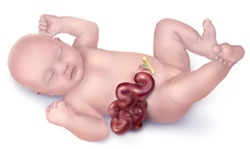Facts about Gastroschisis
Pronounced gas-troh-skee-sis
Gastroschisis is a birth defect of the abdominal (belly) wall. The baby’s intestines stick outside of the baby’s body, through a hole beside the belly button. The hole can be small or large and sometimes other organs, such as the stomach and liver, can also stick outside of the baby’s body.
Gastroschisis occurs early during pregnancy when the muscles that make up the baby’s abdominal wall do not form correctly. A hole occurs which allows the intestines and other organs to extend outside of the body, usually to the right side of belly button. Because the intestines are not covered in a protective sac and are exposed to the amniotic fluid, the bowel can become irritated, causing it to shorten, twist, or swell.
Soon after the baby is born, surgery will be needed to place the abdominal organs inside the baby’s body and repair the defect. After the repair, infants with gastroschisis can have problems with feeding, digestion of food, and absorption of nutrients.
The Centers for Disease Control and Prevention (CDC) estimates that about 1,871 babies are born each year in the United States with gastroschisis.1
Did You Know?
Women can take steps before and during pregnancy to reduce the risk of having a baby born with birth defects. Such steps include taking a daily multivitamin with folic acid (400 micrograms), not smoking, and not drinking alcohol during pregnancy.
Learn more about how to prevent birth defects »
Causes and Risk Factors
Like many families affected by birth defects, CDC wants to find out what causes them. Understanding factors that can increase the chance of having a baby with birth defects will help us learn more about the causes. We are currently working on one of the largest U.S. studies to understand the causes and risk factors for birth defects called the National Birth Defects Prevention Study. This study is looking at many possible risk factors for birth defects, like gastroschisis.
Recently, CDC researchers have reported important findings about some factors that affect the risk of having a baby with gastroschisis:
- Younger age: teenage mothers were more likely to have a baby with gastroschisis than older mothers, and White teenagers had higher rates than Black or African-American teenagers.2
- Alcohol and tobacco: women who consumed alcohol or were a smoker were more likely to have a baby with gastroschisis.3
- Certain medications: use of ibuprofen during pregnancy increased the risk for gastroschisis.4
- Infections: women who reported a genitourinary tract infection just before or during early pregnancy were shown to have an increased risk of having a baby with gastroschisis.4
CDC continues to study birth defects like gastroschisis in order to learn how to prevent them. If you are pregnant or thinking about getting pregnant, talk with your doctor about ways to increase your chance of having a healthy baby.
Diagnosis
Gastroschisis can be diagnosed during pregnancy or after the baby is born.
During Pregnancy
During pregnancy, there are screening tests (prenatal tests) to check for birth defects and other conditions. Gastroschisis might result in an abnormal result on a blood or serum screening test or it might be seen during an ultrasound (which creates pictures of the body).
After the Baby is Born
Gastroschisis is immediately seen at birth.
Treatments
Soon after the baby is born, surgery will be needed to place the abdominal organs inside the baby’s body and repair the defect.
If the gastroschisis defect is small (only some of the intestine is outside of the belly), it is usually treated with surgery soon after birth to put the organs back into the belly and close the opening. If the gastroschisis defect is large (many organs outside of the belly), the repair might done slowly, in stages. The exposed organs might be covered with a special material and slowly moved back into the belly. After all of the organs have been put back in the belly, the opening is closed.
Babies with gastroschisis often need other treatments as well, including receiving nutrients through an IV line, antibiotics to prevent infection, and careful attention to control their body temperature.
References
- Parker SE, Mai CT, Canfield MA, Rickard R, Wang Y, Meyer RE, et al; for the National Birth Defects Prevention Network. Updated national birth prevalence estimates for selected birth defects in the United States, 2004-2006. Birth Defects Res A Clin Mol Teratol. 2010 Sept 28. [Epub ahead of print]
- Williams LJ, Kucik JE, Alverson CJ, Olney RS, Correa A. Epidemiology of gastroschisis in metropolitan Atlanta, 1968 through 2000. Birth Defects Res A. 2005; 73:177-83.
- Bird TM, Robbins JM, Druschel C, Cleves MA, Yang S, Hobbs CA, & the National Birth Defects Prevention Study (2009). Demographic and environmental risk factors for gastroschisis and omphalocele in the National Birth Defects Prevention Study. J Pediatr Surg, 44:1546-1551.
- Feldkamp ML, Reefhuis J, Kucik J, Krikov S, Wilson A, Moore CA, Carey JC, Botto LD and the National Birth Defects Prevention Study. Case-control study of self reported genitourinary infections and risk of gastroschisis: findings from the national birth defects prevention study, 1997-2003. BMJ. 2008 Jun 21; 336(7658): 1420-3.
Contact Us:
- Centers for Disease Control and Prevention
National Center on Birth Defects and Developmental Disabilities
Division of Birth Defects and Developmental Disabilities
1600 Clifton Road
MS E-87
Atlanta, GA 30333 - 800-CDC-INFO
(800-232-4636)
TTY: (888) 232-6348
New Hours of Operation
8am-8pm ET/Monday-Friday
Closed Holidays - cdcinfo@cdc.gov




